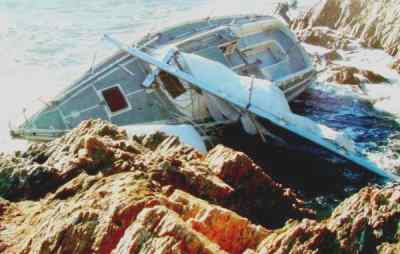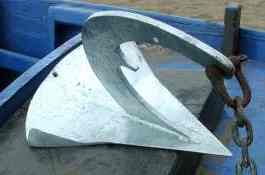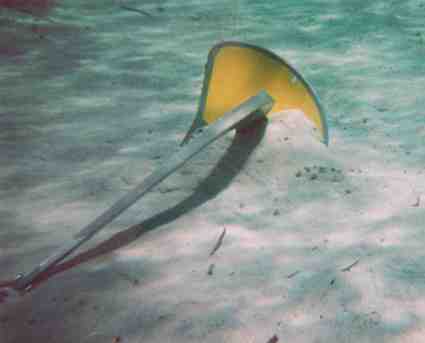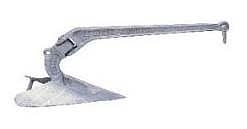|
ANCHORING:
A vessel's anchor is widely
regarded as the most important piece of safety equipment on board and
with good reason.

No
other device has the ability to save both vessel and crew more
frequently, yet more often than not boat builders fit inadequate
anchors. Like everything else, anchoring technology has moved on
considerably over the last twenty years, yet many yachtsmen still rely
on dated anchors. Whilst anchors like the CQR, Danforth and
Bruce have certainly played a key role in anchor development, more
efficient and versatile anchors are now on the market. The idea
of carrying a variety of anchors for different conditions is becoming
less valid.
HISTORY
OF THEIR DEVELOPMENT
It
is a matter of conjecture as to who first had need of and utilized
some ready instrument for mooring his vessel, but much of the early
evolution has been traced by learned men through ancient sculpture,
coins, paintings, etc.
Earliest records of moorings come from Egyptian
tomb furniture 2000 BC
where ship models were equipped with conical stakes and papyrus ropes
for mooring the vessels to the shore. Later tombs 1600 BC yielded ship
models with grooved or perforated anchor stones. When the 1400 BC tomb
of King Tout was opened anchor stones shaped in a T were found. Four
hundred years later, about 1000 BC, Homeric poems still specify
"anchors of stone."
Crooked sticks or wooden frames weighted with stone (Killicks] are
known to have been in use in ancient times; and are still used in
remote regions. Some of these crude anchors show the equivalent of
rudimentary stocks. In 800 BC, two-armed hooks, without stocks, were
cast in bronze on the island of Malta. A Sardinian scarab, 650 BC,
shows a stockless two-armed anchor, which was probably the first
anchor made of iron. Greek writers, 500 BC, mention "stone
anchors with iron hooks". Herodotus relates that stone anchors
were towed astern to steady ships coming down the Nile. A coin of 400
BC shows a two-armed stocked anchor apparently filled with lead.
Its form begins to approximate the "Admiralty" pattern of
recent times. An anchor shown on a Greek coin of about 375 BC,
includes the essentials of an Admiralty anchor, except palms. The
anchor shown on a Syrian coin of about 312 BC, is even more modern in
appearance.
By 300 BC vessels of the Athenian navy were equipped with iron anchors
weighing up to 440 pounds.
Greek coins of 280 BC show anchors with rudimentary palms. An English
anchor shaped from the fork of a yew-tree is ascribed to 100 BC. A
Cyrene iron anchor without palms, and inscribed with the ship's name,
is attributed to about 50 BC. Depictions of iron anchors of the time
of King Herod, about 35 BC, show curious enlargements on the shanks
believed to be carryovers from the times when cylindrical perforated
stones were strung on wooden anchor-shanks, and also show palms on the
arms. Sculptures on the Arch of Tiberius, about 20 AD, show similar
enlargements on the shank, but no palms.
About 40 AD the ship of Emperor Caligua was equipped with a 16 foot
iron tipped oaken anchor with a heavy leaden stock. This was
discovered intact when Lake Nemi, near Rome was drained in 1929. At
the same time there was discovered, after 1800 years submersion, a
wood-sheathed iron anchor weighing about 1000 pounds. Distinguished by
the fact that it had a portable stock, which was an invaluable
convenience lost to the world until "invented" again some
1700 years later and finally adopted by the Admiralty in 1854. In
88-97 AD St. Clement the fourth Pope, is said to have been thrown into
the sea, tied to an anchor a method of execution not uncommon in those
days. From ancient times St. Clement has been the Patron Saint of
Anchorsmiths, who formerly observed his Feast Day on the 23rd of
November.
Iron anchors are said to have been first forged in England (East
Anglia] in 573 AD The Danish "Oseburg Anchor," about 800
A.D., had very small palms, and was constructed for use with a wooden
stock.
The medieval anchor of 1066 AD as depicted in a Bayeau tapestry looks
almost modern.
The Statutes of Genoa of 1441 AD required a 1500-ton ship to carry 12
iron anchors of from 1600 to 1800 pounds each. A Florentine engraving
of 1450 AD shows a two-piece wooden stock of the style popular for the
following 400 years.
The "Sovereign of the Seas," 1600 tons, in 1637 carried 12
anchors of 4000 pounds each. In 1690 Sir Wm. Phipps in his attack on
Quebec lost a thirteen-foot anchor, (recovered in modern times].
Anchors of about 1700 had long shanks, straight arms at 50 degrees,
sharp points at the crown, large diameter rings, and wooden stocks the
length of the shank or longer. An anchor of this style marked
"1703" was reclaimed from the wreck of a 100gun ship sunk at
Sheerness, England.
In 1723 Reaumur issued in France the first public exposition of the
science and art of anchor construction. In 1780 iron stocks began to
emerge from the experimental stage, but the popular anchors of the
period still had wooden stocks and relatively long shanks and straight
arms. In 1801 and succeeding years Richard Pering of England greatly
improved the quality of welds in anchors, shortened the shanks and put
more curvature into the arms.
In 1804 Captain Hawke of the Royal Navy applied for an iron stocked
anchor for his ship and was derided, but 1807 permitted the use of
iron stocks in anchors of not over 1500 pounds. In 1818 Lieutenant
Belcher of the Royal Navy introduced the tumbling fluke, later
improved by Honibal and Porter. With cantpalms added by Trotman, the
anchor became quite popular. From 1820 onward some hundred different
types of "improved" anchors were patented in rapid
succession practically all regarded today as "freaks."
In 1822 and 1823 Lowen and Lawkins experimented with tripping
anchor-palms and stockless shanks, some 40 years before these features
won general acceptance. In 1830 Pering adapted steam power to the
operation of the heavy falling weights used in the welding of anchors.
Rodgers introduced his "Patent Small-Palm Anchor and won
considerable public favor. The Royal Navy now began to concede the
superiority of iron stocks. By 1840 the Hawkins patent tumbling fluke
stockless anchor and developed to a form approximating that of most
stockless anchors of today.
By 1846 the Royal Navy completely surrendered to the iron stock and
gave full sanction to the type of anchors now known as the
"Admiralty" anchor. This type of anchor, also known as
"Old Style" or "Kedge" is no longer used for large
ships but continues in use for small boats and for moorings. Although
it has great holding power in a penetrable bottom it is extremely
awkward and the long stock is vulnerable to mechanical damage. When in
position the upstanding arm may foul a chain or pierce the hull of a
vessel. The "one" arm version is popular for moorings and is
equipped with a second shackle for easier placement.
In 1852 a British Commission declared the Trotman anchor
"Best". By 1859 the Mushroom type of anchor appeared as an
instrument especially suited for permanent moorings. With the removal
of the stock, from Mertom's anchor of 1861 and the advent of Lathem's
anchor 1886 the use of stockless tumbling-fluke anchors increased
rapidly. In 1866 the ball-and-socket type of stockless anchor first
appeared in England.
In 1870 A. F. White stowed the stocks of "old style" anchors
by sliding them down a shank designed with a quarter-twist. In 1873 C.
F. Herreshoff constructed a four-piece de mountable old-style anchor
for a time widely acclaimed by yachtsmen. "Freak" anchors
continuously appeared; for example the Tyzack singlefluke anchor of
1877.
By 1885 Baxter was stowing his Stockless Anchors in a hawse pipe. This
innovation proved of utmost importance, for from that day forward, the
Stockless Anchor increased in popularity until today it is practically
the only type of anchor used on ships of real size.
American styles incline to be chunky, with comparatively broad and
blunt flukes. The U.S. Navy's version has flukes somewhat longer and
of greater area. European anchors, in general, tend to more curvature
and to smaller and sharper flukes. The stockless anchor used today, on
ships of size that are likely to encounter any and all types of sea
bottom, reflect the experience of mariners for the past twenty five
hundred years in compromising between pure dead weight for very hard
bottoms and on the other hand ability to bite and to hold well in soft
bottoms. The stockless anchor is ruggedly built, will handle and stow
easily and readily disengage from sea-bottoms and submerged wreckage.

Modern
Ocean Anchor
With
its concave wedge shape and single penetrating tip, the Spade anchor
is simplicity itself, yet its proven effectiveness is far from
coincidence... ...The
angle of attack has been carefully calculated for the optimum
penetration, the high visibility concave blade has been shaped for
maximum holding power and the anchor has been designed so that 50% of
its total weight is positioned directly over the chisel-like tip to
maximized the penetrating force. It is available in galvanized
steel, marine grade aluminium or stainless steel and by simply
removing one non-load bearing bolt the shaft removes for easy stowage.
In the attempt to successfully stow stocked anchors in
hawsepipe, in
1885 Tyzack revived and ancient practice of placing a stock through or
near the head of the anchor, instead of at the shackle end, as in
Western custom. Examples of this type are the Tyzack anchor, the
Hartness anchor 1886, the Brown anchor 1894, the Hein anchor 1916, the
Croseck anchor 1935 and the Danforth anchor 1943. This particular type
of anchor is somewhat modified by Mr. H. P. Shipley of the U.S. Navy.
These "head stocked" anchors have the advantage of high
holding power, in proportion to weight, in soft bottoms of suitable
penetrability; but are difficult to "break out" if fouled in
rocks or wreckage. Like the "old style" anchor, the
protruding stocks are exceedingly vulnerable. About the time of the
first World War, the Eels Stockless Anchor was developed and has been
used extensively for salvage and mooring purposes.
Recognizing the fundamental superiority of the stockless tumbling
fluke anchor, that first appeared in England in 1866, Frederick Baldt
developed and improved it in 1897. This wrought iron anchor had the
head and shank connected with a ball and socket joint, the shank being
round and resolvable to act as a built-in swivel. Baldt strengthened
the shank by making it rectangular in lieu of round and produced it in
cast steel. He took out patents for further modifications and his
patent of 1901 was of such superior design and quality that the words
"Baldt" and "Stockless Anchor" have become
practically synonymous.
In 1949 Baldt Anchor, Chain & Forge announced the development of
the "Baldt Lightweight Stockless Anchor" A modification of
the stockless principle. This anchor develops the greatest holding power known today and is
the choice of experienced offshore drilling companies to moor oil
drilling rigs in oceans throughout the world.
The "Snug Stowing Stockless Anchor" was patented August 24,
1954 by Messrs. Linnenbank, Money, and Noel. This anchor was developed
to house freely on shipboard with minimum protrusion and maximum
bearing on shell of ship. It facilitates fabrication of simplified
hawse pipes and its design helps prevent the rush of water inboard
through the hawse pipe during high seas.
Persons interested in Maritime History will find one of the most
extensive collections of maritime artifacts in the world at the
Mariners Museum in Newport News, Virginia. Baldt has donated many
exhibits. Also, The Navy Museum, located at the Washington Navy Yard,
Washington, D.C. has many fine exhibits.

1831-1860:
Chain Cables & The Admirality Anchor
-
-
In the year 1831 chain cable began to supersede the hempen ones,
with the result that the long-shanked anchors hitherto in vogue were
no longer necessary, and anchor with shorter shanks and with heavier
and stronger crowns gradually came into use. In consequence of these
changes, a commission was appointed in the year 1838 to inquire into
the holding power of anchors, and a principal result of their labors
was the adoption of the so-called admiralty pattern anchor, which
continued to be used in the navy up to 1860. The invention of the
steam hammer in 1842 made the welding of heavy masses of iron a
comparatively easy and reliable process, so that from this time
onward the strength of anchors fully kept pace with that of the
chain cables which had come into general use.
Baldt
Stockless Anchor
The Baldt
Stockless Anchor was patented by Frederick Baldt in 1896...
BALDT,
Inc.
tel: 610.447.5200
fax: 610.874.8599
801 W. 6th Street
Chester, PA 19013
chain@baldt.com
CQR
ANCHOR is the original, genuine drop-forged high tensile patented
anchor. Made in Scotland. Has immense holding power in sand, pebble,
rock, grass, kelp and coral. Proven hinged action design means no
break out or fouling with wind shifts. Hot drop forged high tensile
steel gives it superior strength. Approved by Lloyds Register of
Shipping (London). Weight: 45 lbs. Holding power 4000 lbs.

History
And Development Of The Marine Anchor
History
And Development Of Anchor Chain
Lloyds
Register Chronology of Anchor Chain
1902
Scientific American Article
History
of Anchors Aweigh

Fleet
operators might reduce insurance costs if their ships have
autonomous
capability.
|




